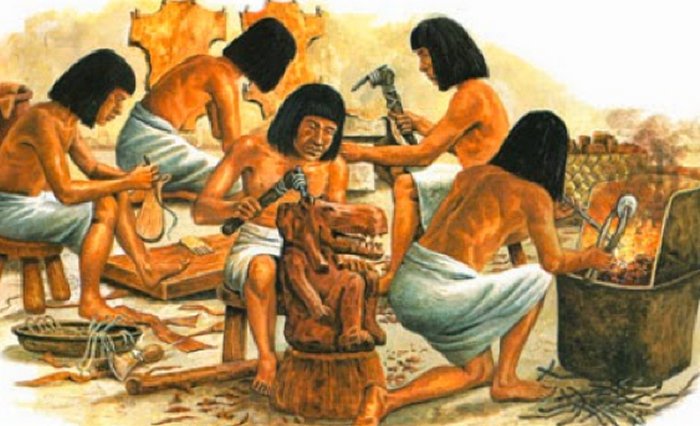What Ancient Civilization Discovered Metallurgy?
AncientPages.com - The science behind metallurgy goes far back in time, but it's uncertain when and where humans invented metal smelting.
Researchers now think they have found the answer to this long-debated question in the history of technology. Apparently, metallurgy does not have a single origin, but probably arose at various locations at about the same time.
The experts reached this conclusion after re-examining the 8,500-year-old copper slag and analyzing the chemical composition of other copper artifacts from the Stone Age settlement of Çatalhöyük in the Near East.
Scientists have debated for a long time who discovered metallurgy.
There is evidence copper metal was already being processed at the beginning of the Neolithic Age approximately 10,000 years ago in the Fertile Crescent from the Levant through East Anatolia to the Zagros Mountains in Iran.
"But because this is all pure, native copper, we can't really call it true metallurgy," explains Prof. Dr Ernst Pernicka, Scientific Director of Heidelberg University's Curt Engelhorn Centre for Archaeometry, which is located in Mannheim.
Copper is found in nature as metal, and according to the researchers, was probably considered a special type of stone. But because the production of metal from ore ushers in a new era in human history, it is important to know when and where it first developed and whether metal smelting really originated in a single location.
See also:
Aluminum Was Used At Least 7,000 Years Ago – Long Before The Metal’s Official Invention In 1825
Telangana And Great Ancient Iron Masterwork Of Skilled Blacksmiths Of India
It was long believed that a small amount of copper slag from the Neolithic site at Çatalhöyük was thought to be the earliest evidence for pyrometallurgical extraction of copper from ore.
This settlement existed from approximately 7,100 to 6,000 BC and is considered to be the most significant site in the Near East that affords any insight into the development of human habitats. The copper slag was located in layers that dated back to 6,500 years before Christ and was therefore 1,500 years older than the world's earliest evidence of copper smelting.
Copper bead from Çatalhöyük. It consists of very pure copper in metal form, as found in nature. Image credit: Picture: M. Radivojevic, CC BY-NC-SA 3.0
"The find seemed to point to the birthplace of metallurgy, with the technology slowly spreading from there in all directions," states Prof. Pernicka, who also heads the Archaeometry and Archaeometallurgy Research Group at the Institute of Earth Sciences at Heidelberg University.
However new studies, including those at the Curt Engelhorn Centre for Archaeometry, have demonstrated that the slag was an unintentional by-product of a domestic fire. The extreme heat of the fire slagged the green copper ores, which were used as pigment. The slag differs in chemical composition from another artefact from the Stone Age settlement, a bead of folded sheets made of pure copper.
This threw new light on the scientific significance of the copper slag of Çatalhöyük, now putting the earliest known examples of copper extraction from ore around 5,000 BC in Southeast Europe and Iran.
The current findings indicate that this revolutionary development in humankind probably came about at roughly the same time but in multiple locations. "We thereby solved a controversial problem in the history of technology," underscores Professor Pernicka.
AncientPages.com
Expand for referencesMore From Ancient Pages
-
 1,500-Year-Old Ancient Lamps Unearthed In Zerzevan Castle In Southeast Turkey
Archaeology | Nov 25, 2019
1,500-Year-Old Ancient Lamps Unearthed In Zerzevan Castle In Southeast Turkey
Archaeology | Nov 25, 2019 -
 Unraveling The Mystery Of The Celestial Matrix
Featured Stories | Sep 30, 2021
Unraveling The Mystery Of The Celestial Matrix
Featured Stories | Sep 30, 2021 -
 Adad ‘Lord Of Abundance’- Mesopotamian Weather God Who Was Responsible For Fertility, Wealth And Oracles
Featured Stories | Mar 11, 2020
Adad ‘Lord Of Abundance’- Mesopotamian Weather God Who Was Responsible For Fertility, Wealth And Oracles
Featured Stories | Mar 11, 2020 -
 Unravelling The Mystery Of The Ulfberht Sword – An Ancient Viking Artifact Far Ahead Of Its Time
Artifacts | Feb 11, 2014
Unravelling The Mystery Of The Ulfberht Sword – An Ancient Viking Artifact Far Ahead Of Its Time
Artifacts | Feb 11, 2014 -
 Glima – Ancient Martial Art Practiced By The Vikings Is Still Popular Today
Ancient Traditions And Customs | Mar 7, 2017
Glima – Ancient Martial Art Practiced By The Vikings Is Still Popular Today
Ancient Traditions And Customs | Mar 7, 2017 -
 Sun: Highest Cosmic Power Worshiped By Ancient People And Represented By Deities
Featured Stories | Apr 1, 2019
Sun: Highest Cosmic Power Worshiped By Ancient People And Represented By Deities
Featured Stories | Apr 1, 2019 -
 TB Was Transmitted in South America – DNA Study Shows How It Happened
Archaeology | Mar 17, 2022
TB Was Transmitted in South America – DNA Study Shows How It Happened
Archaeology | Mar 17, 2022 -
 Evidence Of Neolithic Bird Hunting In Upper Mesopotamia
Archaeology | Sep 27, 2023
Evidence Of Neolithic Bird Hunting In Upper Mesopotamia
Archaeology | Sep 27, 2023 -
 On This Day In History: Cyrus The Great Enters Capital Of Babylon And Allows Jews Return To Their Land – On Oct 29, 539 BC
News | Oct 29, 2016
On This Day In History: Cyrus The Great Enters Capital Of Babylon And Allows Jews Return To Their Land – On Oct 29, 539 BC
News | Oct 29, 2016 -
 On This Day In History: Julius Caesar Dedicated Temple To Venus Genetrix – On Sep 26, 46 BC
News | Sep 26, 2016
On This Day In History: Julius Caesar Dedicated Temple To Venus Genetrix – On Sep 26, 46 BC
News | Sep 26, 2016 -
 Unique Medieval Spindle Whorl With Cyrillic Inscription Discovered In Poland
Archaeology | Mar 9, 2018
Unique Medieval Spindle Whorl With Cyrillic Inscription Discovered In Poland
Archaeology | Mar 9, 2018 -
 Flexible Glass – Lost Ancient Roman Invention Because Glassmaker Was Beheaded By Emperor Tiberius
Ancient Technology | Jul 27, 2023
Flexible Glass – Lost Ancient Roman Invention Because Glassmaker Was Beheaded By Emperor Tiberius
Ancient Technology | Jul 27, 2023 -
 History Of Middle Ages Altarpieces Has Been Re-Written
Archaeology | Mar 10, 2018
History Of Middle Ages Altarpieces Has Been Re-Written
Archaeology | Mar 10, 2018 -
 Catequil – Inca God Of Thunder And Lightning Who Predicted The Future And Was Cultural Hero Of Inca People
Featured Stories | Nov 11, 2023
Catequil – Inca God Of Thunder And Lightning Who Predicted The Future And Was Cultural Hero Of Inca People
Featured Stories | Nov 11, 2023 -
 Ancient Great City Of Ani: Lost Capital Of The Kingdom Of Armenia And Its Mysterious Underground Tunnels
Featured Stories | Feb 18, 2016
Ancient Great City Of Ani: Lost Capital Of The Kingdom Of Armenia And Its Mysterious Underground Tunnels
Featured Stories | Feb 18, 2016 -
 Strange Ancient Artifacts And Foreigners Who Were Not Meant To Be In North America
Artifacts | Mar 16, 2020
Strange Ancient Artifacts And Foreigners Who Were Not Meant To Be In North America
Artifacts | Mar 16, 2020 -
 Levänluhta People Could Survive Fimbulwinter Thanks To Their Diverse Livelihoods
Archaeology | Apr 24, 2020
Levänluhta People Could Survive Fimbulwinter Thanks To Their Diverse Livelihoods
Archaeology | Apr 24, 2020 -
 2,000-Year-Old Smuggled Glazed Bricks Sent Back To Iran By Switzerland
Artifacts | Dec 29, 2020
2,000-Year-Old Smuggled Glazed Bricks Sent Back To Iran By Switzerland
Artifacts | Dec 29, 2020 -
 Strange And Scary Encounter With Ancient Giants In North America
Featured Stories | Sep 23, 2021
Strange And Scary Encounter With Ancient Giants In North America
Featured Stories | Sep 23, 2021 -
 Huginn and Muninn: Powerful Ravens Of Odin, Supreme God In Asgard In Norse Mythology
Featured Stories | Dec 7, 2017
Huginn and Muninn: Powerful Ravens Of Odin, Supreme God In Asgard In Norse Mythology
Featured Stories | Dec 7, 2017


